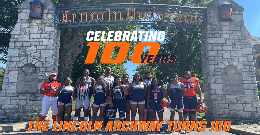- Posted in All University
- Category: AthleticsCampus News
LINCOLN UNIVERSITY, Pa. - When the Lincoln University football team takes the field Saturday during its Homecoming game, the Lions will be donning a symbol of history.
The orange Under Armour uniform top that will be traditionally worn at Homecoming with the orange pants were designed to pay homage to one of the signature landmarks on the Chester County campus.
This year marks the centennial of the Alumni Memorial Arch that sits at the opening of the campus. According to research, spearheaded by this year’s senior class when they were freshmen in their First Year Experience class, the arch is the first monument of any kind erected by men of color dedicated in honor of the Negro Soldier who served our country.
Lincoln University alumni paid for the Arch, which was officially dedicated during the 1921 Commencement ceremony by 1893 graduate George E. Cannon. The day before the official dedication, U.S. President Warren G. Harding, his wife, and members of his staff visited campus. While addressing the students and faculty at the arch, President Harding said of the arch, “God grant thee in the soberness, the fairness and the justice of the country, we shall never again have a spectacle like it”.
“As we honor this momentous occasion of 100 years of this memorial archway, I am excited to showcase how athletics is an integral part of telling the Lincoln University story,” said Lincoln University Director of Athletics and Recreational Services Harry Stinson III. “Everything we do within athletics is designed to help tell the story of this amazing institution. As we create pathways to the future we also pay homage to our past. The orange uniforms throughout athletics are just one way to do so and the football uniform is just one example of how we accomplish this goal. I am overjoyed to see our vision come to life with a true celebration of a historic landmark of the university.”
One of the biggest sites and most recognizable locations on Lincoln's campus is the Memorial Archway at the front gate of the university. Stinson saw that as the location on campus that students began and ended their academic career and symbolized Lincoln. That sparked an idea to utilize uniforms to pay homage, tell the story of Lincoln, and would provide something that could be webbed into the fabric of the athletic department. With Lincoln now using Under Armour and recently changing the athletic logo, here was the opportunity to implant the idea.
The idea was to give Lincoln a visual identity that differentiated them from other competitors whose school colors are also Orange and Blue. Up until that point, the department used blue as the primary color for uniforms and athletic apparel. Having an orange uniform would set Lincoln apart from its competitors including Morgan State and Virginia State, who don Blue and Orange as well.

The archway is primarily orange with white stone and blue accents including a blue lantern, and Lincoln written in orange across a blue arch.
Stinson's idea of creating an all-orange uniform that would represent the true Orange and Blue Spirit could come to life through a representation of the archway. The Archway was webbed into the design of the uniform by creating bands across the shoulder of the uniform, symbolizing not only the archway but also the lantern that provides a beacon of light for the future. Across the archway are the words Lincoln University in old English script and we added Lincoln on the front of the uniforms in script font to tie in the archway even more to the uniform. The piping down the pants that state Lions represent the two lions that sit protecting the archway.
Kickoff is slated for 1 p.m. Saturday against Elizabeth City State University at Coatesville Area High School.
